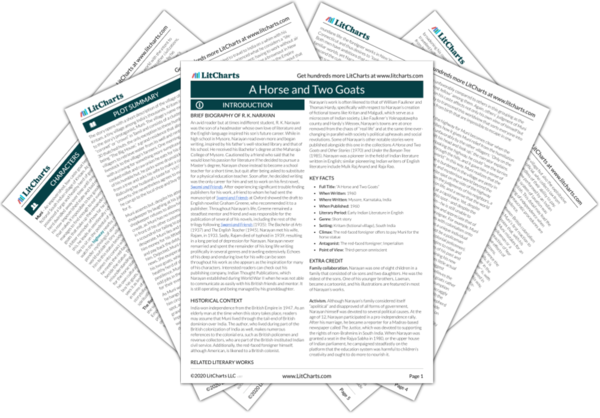Welcome to the LitCharts study guide on R. K. Narayan's A Horse and Two Goats. Created by the original team behind SparkNotes, LitCharts are the world's best literature guides.
A Horse and Two Goats: Introduction
A Horse and Two Goats: Plot Summary
A Horse and Two Goats: Detailed Summary & Analysis
A Horse and Two Goats: Themes
A Horse and Two Goats: Quotes
A Horse and Two Goats: Characters
A Horse and Two Goats: Symbols
A Horse and Two Goats: Theme Wheel
Brief Biography of R. K. Narayan

Historical Context of A Horse and Two Goats
Other Books Related to A Horse and Two Goats
- Full Title: “A Horse and Two Goats”
- When Written: 1960
- Where Written: Mysore, Karnataka, India
- When Published: 1960
- Literary Period: Early Indian Literature in English
- Genre: Short story
- Setting: Kritam (fictional village), South India
- Climax: The red-faced foreigner offers to pay Muni for the horse statue
- Antagonist: The red-faced foreigner; Imperialism
- Point of View: Third-person omniscient
Extra Credit for A Horse and Two Goats
Family collaboration. Narayan was one of eight children in a family that consisted of six sons and two daughters. He was the eldest of the sons. One of his younger brothers, Laxman, became a cartoonist, and his illustrations are featured in most of Narayan’s works.
Activism. Although Narayan’s family considered itself “apolitical” and disapproved of all forms of government, Narayan himself was devoted to several political causes. At the age of 12, Narayan participated in a pro-independence rally. After his marriage, he became a reporter for a Madras-based newspaper called The Justice, which was devoted to supporting the rights of non-Brahmins in South India. When Narayan was granted a seat in the Rajya Sabha in 1980, or the upper house of Indian parliament, he campaigned steadfastly on the platform that the education system was harmful to children’s creativity and ought to do more to nourish it.







